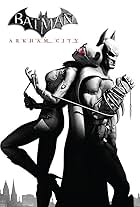When conflict erupts on the planet of Pandora between a space-faring consortium and the Na'vi, gamers will find themselves thrust into a fight for the heart of a planet and the fate of a civ... Read allWhen conflict erupts on the planet of Pandora between a space-faring consortium and the Na'vi, gamers will find themselves thrust into a fight for the heart of a planet and the fate of a civilization.When conflict erupts on the planet of Pandora between a space-faring consortium and the Na'vi, gamers will find themselves thrust into a fight for the heart of a planet and the fate of a civilization.
Roger Craig Smith
- Na'vi
- (voice)
Nolan North
- Boss Conrad
- (voice)
Liam O'Brien
- RDA
- (voice)
Keith Silverstein
- Na'vi
- (voice)
Parisa Fakhri
- Unipey
- (voice)
- …
Robin Atkin Downes
- Na'vi
- (voice)
- …
Peter Renaday
- RDA
- (voice)
James Urbaniak
- RDA
- (voice)
Bumper Robinson
- Batista
- (voice)
- …
Audrey Wasilewski
- Abel Ryder
- (voice)
Marcella Lentz-Pope
- Kyuna
- (voice)
- …
Kimberly Brooks
- Kendra Midori
- (voice)
- …
James Horan
- RDA
- (voice)
- Director
- Writers
- All cast & crew
- Production, box office & more at IMDbPro
Storyline
Did you know
- TriviaThe first console video game to be playable in stereoscopic 3D, though it only supports Side-By-Side, Top-And-Bottom, and other now defunct methods of stereoscopy. The game does not support Frame-Packing 3D, as it was released before the Blu-ray 3D format was created/finalized. This therefore also makes it one of the earliest forms of entertainment to properly utilize 3DTVs.
- GoofsPandora is supposed to have less gravitational forces than those of Earth. It's the main explanation for why creatures and plants grow so much larger there. However, if a human character falls from a height considered survivable on Earth they will still die.
- ConnectionsReferenced in The Gadget Show: Web TV: Episode #1.91 (2010)
Featured review
James Cameron's Avatar: The Game is a video game adaptation of the popular movie that takes us into the captivating world of Pandora. The game successfully recreates the universe, with events set two years before the film, giving players a unique opportunity to explore and interact with this fantastic environment.
For its time, the game features impressive graphics. The developers skillfully conveyed the beauty of Pandora, drawing players in with picturesque landscapes and fantastical creatures.
The controls are generally smooth, but unfortunately, one aspect that may cause some dissatisfaction is the handling of airborne vehicles. In this regard, the game can feel less intuitive and challenging for many players.
However, the game's main highlight is the option to choose a side in the conflict. Players can decide whether to join the humans or the Na'vi, experiencing the depth of the conflict shown in the film. This adds a strategic element to the gameplay, making each playthrough unique.
One of the game's greatest strengths is its visual presentation. The vibrant landscapes of Pandora come to life through detailed graphics, making exploration a treat. The lush forests, mysterious creatures, and the overall atmosphere are beautifully recreated, allowing players to immerse themselves in the world they've seen on the big screen. Small details, like glowing flora and diverse fauna, contribute to the game's charm, making the environment feel alive.
Despite the engaging visuals, the game isn't without its flaws. While the overall control scheme feels comfortable and responsive, handling aerial vehicles can be particularly frustrating. This aspect of the gameplay lacks the intuitive feel of the rest of the controls, leading to moments of confusion and difficulty, especially when quick maneuvers are required in mid-air. This flaw could be a significant deterrent for some players, but it doesn't entirely overshadow the game's positives.
The ability to choose a side in the conflict between humans and the Na'vi is a key feature that elevates the gameplay. This decision impacts not only the story but also the strategies and tools available to the player. Choosing the human side grants access to advanced technology and weapons, allowing players to engage in battles from a distance and utilize high-tech equipment to dominate the Pandora landscape. On the other hand, siding with the Na'vi opens up the possibility of using the planet's natural power, relying on agility, nature-based weapons, and strong connections with the environment. This dual-choice system encourages strategic thinking and enhances the emotional investment in the storyline.
Additionally, the option to choose between the two factions adds significant replay value. Players can experience the game from both perspectives, offering a fresh take on the narrative and gameplay mechanics with each playthrough. This increases the depth of the game, as each faction provides its own unique challenges and advantages, making Avatar: The Game more than just a one-time adventure.
Despite some technical shortcomings, like the tricky aerial controls and occasionally predictable gameplay elements, James Cameron's Avatar: The Game remains a compelling experience for fans of the movie and action-adventure games in general. It allows players to immerse themselves in the incredible world of Pandora, offering a good balance of action and strategic decision-making. For those looking to revisit the world of Avatar or discover it for the first time in a new way, this game offers a solid experience.
In conclusion, Avatar: The Game deserves attention from both fans of the movie and lovers of high-quality adventure games. It successfully captures the atmosphere of Pandora, offers engaging gameplay, and allows players to feel like part of the expansive Avatar universe.
For its time, the game features impressive graphics. The developers skillfully conveyed the beauty of Pandora, drawing players in with picturesque landscapes and fantastical creatures.
The controls are generally smooth, but unfortunately, one aspect that may cause some dissatisfaction is the handling of airborne vehicles. In this regard, the game can feel less intuitive and challenging for many players.
However, the game's main highlight is the option to choose a side in the conflict. Players can decide whether to join the humans or the Na'vi, experiencing the depth of the conflict shown in the film. This adds a strategic element to the gameplay, making each playthrough unique.
One of the game's greatest strengths is its visual presentation. The vibrant landscapes of Pandora come to life through detailed graphics, making exploration a treat. The lush forests, mysterious creatures, and the overall atmosphere are beautifully recreated, allowing players to immerse themselves in the world they've seen on the big screen. Small details, like glowing flora and diverse fauna, contribute to the game's charm, making the environment feel alive.
Despite the engaging visuals, the game isn't without its flaws. While the overall control scheme feels comfortable and responsive, handling aerial vehicles can be particularly frustrating. This aspect of the gameplay lacks the intuitive feel of the rest of the controls, leading to moments of confusion and difficulty, especially when quick maneuvers are required in mid-air. This flaw could be a significant deterrent for some players, but it doesn't entirely overshadow the game's positives.
The ability to choose a side in the conflict between humans and the Na'vi is a key feature that elevates the gameplay. This decision impacts not only the story but also the strategies and tools available to the player. Choosing the human side grants access to advanced technology and weapons, allowing players to engage in battles from a distance and utilize high-tech equipment to dominate the Pandora landscape. On the other hand, siding with the Na'vi opens up the possibility of using the planet's natural power, relying on agility, nature-based weapons, and strong connections with the environment. This dual-choice system encourages strategic thinking and enhances the emotional investment in the storyline.
Additionally, the option to choose between the two factions adds significant replay value. Players can experience the game from both perspectives, offering a fresh take on the narrative and gameplay mechanics with each playthrough. This increases the depth of the game, as each faction provides its own unique challenges and advantages, making Avatar: The Game more than just a one-time adventure.
Despite some technical shortcomings, like the tricky aerial controls and occasionally predictable gameplay elements, James Cameron's Avatar: The Game remains a compelling experience for fans of the movie and action-adventure games in general. It allows players to immerse themselves in the incredible world of Pandora, offering a good balance of action and strategic decision-making. For those looking to revisit the world of Avatar or discover it for the first time in a new way, this game offers a solid experience.
In conclusion, Avatar: The Game deserves attention from both fans of the movie and lovers of high-quality adventure games. It successfully captures the atmosphere of Pandora, offers engaging gameplay, and allows players to feel like part of the expansive Avatar universe.
Details
- Release date
- Countries of origin
- Official site
- Language
- Also known as
- James Cameron's Avatar: The Game
- Production companies
- See more company credits at IMDbPro
- Color
Contribute to this page
Suggest an edit or add missing content





































